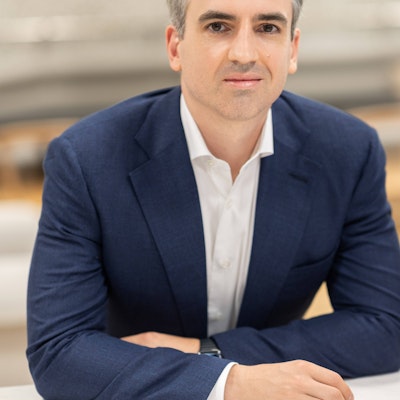
Interview Descartes
At the forefront of climate risk mitigation, Descartes stands as a global leader with a profound commitment to understanding and addressing the challenges posed by climate change. Founded in late 2018 by Sébastien Piguet (Chief Underwriting Officer), Kevin Dedieu (Chief R&D Officer) and myself, Tanguy Touffut (CEO) Descartes already has a worldwide presence, with fourteen offices in nine countries, $140.8 million raised and client base of over 400 large corporates spanning a wide variety of industries.
The core strength of Descartes lies in its diverse and highly specialized team of over 100 industry experts, among a total of 180 staff members. Comprising Ph.D. holders with expertise in meteorology, climatology, physics, data science, and software engineering, the team is a formidable force dedicated to unraveling the complexities of climate-related events and emerging risks on a global scale.
Structured both as a Managing General Agency (MGA) globally, and as an insurance carrier within the European Economic Area, this flexibility allows Descartes to offer innovative insurance covers for climate risks and, more recently, for emerging risks such as cyber.
Descartes' approach to understanding and modeling climate change is characterized by a robust technology and data-driven methodology. Beyond statistical analysis, the company embraces physics to gain a forward-looking perspective. Employing a parametric approach, not only for risk modeling but also for streamlining claims processing reflects the company's commitment to efficiency and innovation.
Whether modeling temperature, wind speed, or soil moisture, the company ensures a granular understanding to predict events (wildfire, cyclone, hurricane etc.) in specific regions. This global perspective extends beyond corporate boundaries, actively engaging with large enterprises and governments.
In summary, Descartes has emerged as a trailblazer in climate risk solutions, leveraging a global presence, a specialized team, and innovative operational models to address the urgent challenges posed by climate change.
The following interview promises valuable insights into the company's strategies, challenges, and contributions to reshaping the insurance landscape in the face of climate-related uncertainties.
WHERE IS THE INDUSTRY HEADING TODAY?
While acknowledging that insurers, as a whole, are implementing initiatives around prevention and managing catastrophe claims, some players opt to exit certain markets or reduce coverage in regions prone to climate- related events. This includes insurers withdrawing from high-risk areas for the coverage of events like wildfires in California and Oregon, or cyclones in Florida, Texas, and Louisiana.
The decision to exit certain markets is often prompted by challenges in modeling climate change and the increasing costs associated with losses following natural catastrophes, as well as persistent inflation. The insurance industry, particularly in the non-life sector, currently grapples with significant economic challenges, notably high expense ratios that frequently exceed 30% for most incumbents globally.
A commitment to innovation and pioneering products and features to address climate change means actively working to create a win-win situation among insurers, brokers, and other stakeholders. Consensus is essential in building a win-win ecosystem to ensure financial viability for all parties involved and find sustainable solutions to better finance mitigation actions in the face of an ever-evolving risk landscape
IS PARAMETRIC INSURANCE THE VIABLE OPTION AGAINST CLIMATE RISKS?
Addressing climate change is a multifaceted challenge: there's no one-size-fits-all solution. Parametric insurance, however, stands out for its potential to revolutionize how we navigate these risks. It's not about making assumptions but recognizing a powerful tool in our arsenal.
Parametric insurance offers a pathway to optimize the economics of climate risk coverage. It allows for cost reduction in claim handling, ensuring faster payouts, and transparency in our collaboration with clients regarding accurate and granular pricing.
Today's landscape, marked by events like floods, wildfires, heatwaves, or extreme cold spells, vastly differs from previous decades. Innovation is not just a choice but a necessity. Parametric insurance is not the only option, but it is undeniably prominent as being among the most promising solutions.
The evolving world demands a dynamic approach to risk management. Our commitment is to explore and adapt continually, navigating the complexities of climate and emerging risks of tomorrow with resilience.
HOW CAN PARAMETRIC TRIGGERS BE DEFINED, IMPLEMENTED AND SCALED FOR INSURERS? ARE THERE SPECIFIC MODELS, AND TAILORED TO SPECIFIC PERILS OR COMPANIES?
Parametric insurance, in essence, represents a departure from the traditional insurance model. Picture traditional insurance as an extensive coverage umbrella with a laundry list of exclusions. It often leaves clients in a maze of uncertainty, unsure about what is truly covered. Parametric insurance takes a different route – it ditches exclusions. Instead, it succinctly states what is covered, like floods of a certain depth or typhoons of a given category, providing a clear and concise understanding of one’s coverage.
The clarity offered by parametric insurance is a game-changer. In traditional contracts, you might find yourself wading through a 40-page document, deciphering what is covered and what is not. With parametric triggers, you get a straightforward, often one-page contract tailored to specific perils.
Our team at Descartes Underwriting, consisting of over 180 experts, is dedicated to modeling various weather perils on a global scale. Whether for hurricanes in Florida, typhoons in Japan, or hail storms in Europe, the same global models are utilized, albeit with different data sources. It's about maintaining consistency in our approach.
Another beauty of parametric insurance lies in its flexibility. Corporations have the autonomy to tailor their coverage precisely as they see fit. Whether it's specifying the intensity of a typhoon or determining coverage for a plantation, the decision rests with the clients and their brokers.
The parameters are defined based on what the clients need and want. If a client desires coverage for a specific category of typhoon or a percentage of their plantation area, we adapt accordingly. It's a collaborative effort, driven by the client's budget constraints, risk appetite, and the anticipated frequency of losses.
In conclusion, parametric triggers represent more than just an insurance mechanism – they signify a shift toward simplicity, transparency, and tailored coverage. We believe in empowering our clients with clear and precise insurance solutions, ensuring they know exactly what they are protected against.
WHAT DIFFERENTIATES DESCARTES FROM OTHER PLAYERS, SUCH AS INCUMBENTS, STARTUPS, AND TECHNOLOGY PROVIDERS?
In our journey to redefine the insurance landscape, the question often arises – what sets Descartes Underwriting apart from the rest? The answer lies in our commitment to creating a diverse team: a fusion of tech innovators and seasoned insurance experts.
Creating the perfect mix between tech enthusiasts and insurance veterans is no simple feat. The tech industry and insurance sector operate with different mindsets and expectations. While the allure of the tech world might not seem obvious in the insurance realm, it is crucial for infusing innovation.
We take pride in curating a dynamic team that comprises over 40 nationalities, bringing together individuals with diverse experiences and perspectives. Our workforce is a harmonious blend of seasoned insurance professionals, PhD modelers, underwriters, data scientists, software engineers, and DevOps experts.
Access to a global talent pool is one of our key strengths, enabling us to stay at the forefront of innovation. But it's not just about having a diverse team; it's about collaboration. Our close partnership with brokers has been instrumental in our success. We recognize the importance of working hand in hand with those who understand the intricacies of the industry.
One of our defining characteristics is the scale of our modeling team. We are on track to have the largest modeling team in the insurance industry by the end of the year. This places us ahead, not just as a company, but as a driving force in climate and catastrophe risk modeling.
Our collaboration extends beyond brokers to also include key partnerships with insurers, such as with Generali, highlighting our commitment to paving the way for the economic and business resilience of tomorrow. In the vast challenge of addressing climate change, no single entity can make a significant impact alone. It's a collective effort, and Descartes Underwriting plays its part in collaboration with brokers, insurers, and the broader industry.
Our focus is not a zero-sum game in this intricate dance of collaboration. We strive to enhance products, improve economics, and ensure that everyone in the chain – from innovators to claims handlers – reaps the rewards of their efforts. Descartes Underwriting is not just a company; it's an evolving force, poised to become the largest in natural catastrophe risk modeling and, by extension, a catalyst for positive change.
WHAT TECHNOLOGIES ARE ESSENTIAL FOR IMPLEMENTING PARAMETRIC COVERAGE IN NATURAL CATASTROPHE INSURANCE, AND CAN YOU PROVIDE AN EXAMPLE OF A SUCCESSFUL CASE?
In parametric insurance, two key technologies play a pivotal role. Firstly, data is the backbone. We harness the power of satellite imagery, radar technology, IoT devices, reliable data sources and data analytics. It’s about collecting many data points that provide crucial insights into the dynamics of natural disasters. The more data we have, the better we can understand and predict these events. Thanks to technological advancements, the world is witnessing a surge in data sources, which we can leverage to revolutionize the industry.
Complementing our implementation of data is the application of artificial intelligence (AI) techniques. Machine learning and neural networks are formida- ble tools in our arsenal. Machine learning, in particular, has proven its prowess in diverse applications. When it comes to satellite imagery, computer vision and neural networks come into play, enhancing our ability to process and interpret the vast datasets associated with natural catastrophes.
Let's delve into a tangible example – the case of hailstorms and solar panels. Imagine insuring solar panels in different parts of the world, be it Europe, Asia, or North America. The potential destruction of solar panels due to hailstones is a real risk. Our ability to assess the size and speed of hailstones allows us quantify the amount of kinetic energy exerted by falling hail. This, in turn, informs us about potential losses that renewable energy players may face after a hailstorm.
In this scenario, we've crafted a sophisticated approach. The complexity lies in modeling the behavior of hailstorms and leveraging specific data sources to expedite claim payments. For instance, if the hailstones exceed a certain size, causing damage to solar panels, this enables a swift payout within a few days. This agility is crucial for returning to normal operations and minimizing losses for the insured.
Currently, this approach has gained significant traction in North America, with Europe catching up steadily. It underscores the global applicability of our technology-driven solutions in the domain of natural catastrophe insurance.
In essence, our success story lies in the fusion of robust data innovations and AI techniques, enabling us to not only predict but proactively respond to the challenges posed by natural disasters. It's not just insurance; it's a tech-driven evolution in the way we safeguard against the unpredictable forces of nature.
IN THE TRADITIONAL INSURANCE MODEL, PREMIUMS ARE EXCHANGED FOR COVERAGE. HOW WOULD YOU CHARACTERIZE YOUR INNOVATIVE BUSINESS MODEL, AND DO THE REVENUE STREAMS DIFFER FROM THE TRADITIONAL INSURANCE MODEL?
It's actually the same model. The only difference is that we are working very hard to minimize functional costs. So again, we want to avoid being a loss-adjusting fee; we want to ensure that we will pay quickly and fight inflation (the quicker you pay, the quicker you repair, the less damages occur..). Otherwise, it's still the same mechanism, the insured will pay a premium in exchange for coverage. That's simple. We strive to give back more to the end client and, of course, to secure profitability for the reinsurer and insurance industry.
Descartes stands at the forefront of this transformative journey, rewriting the rules and redefining the narrative around insurance affordability demonstrating that insurance can be both effective, transparent and accurate.
Subscribe to Our Newsletter
Get the latest insights about Global solutions for leading insurers on your email

